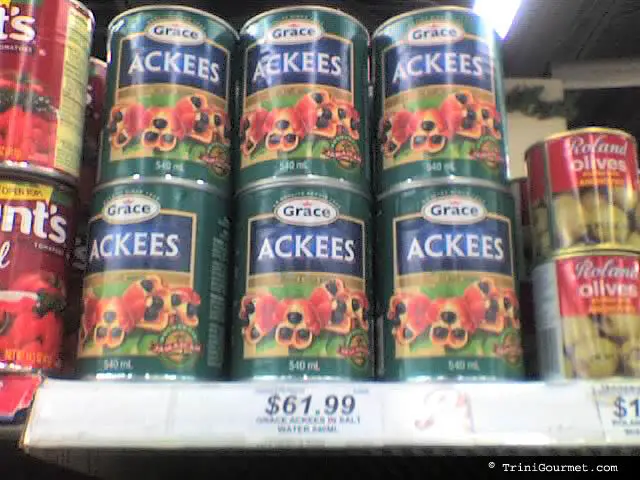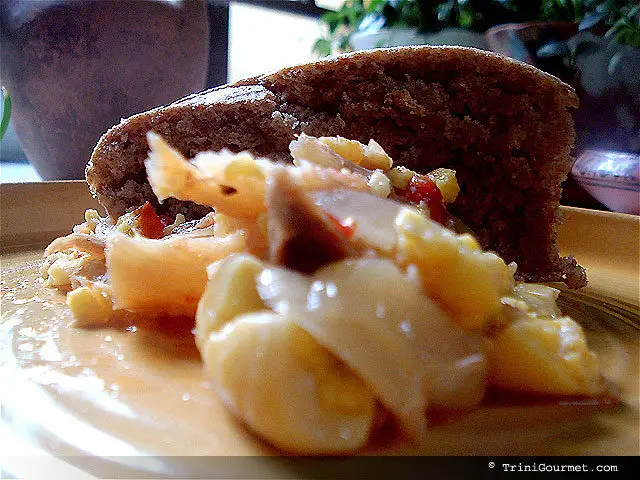Ackee
Ackee is one of my favorite ingredients, however it is not something that I think most Trinidadians (or people worldwide) know or have tasted. In fact if it wasn’t for my Jamaican mother I probably would never have tasted it all!
I often see Western cookbooks comparing ackee to scrambled eggs, a comparison that I believe is more visual than taste-related. Ackee has a very creamy texture and is relatively mild in flavour. For this reason, like tofu, it does best when paired with assertive flavours and ingredients (such as the saltfish and peppers in Jamaica’s national dish ‘Ackee and Saltfish’). When it is paired with such flavours it absorbs them like a happy sponge and truly becomes something worth talking about!
Great care must be taken when harvesting ackee though as it can be quite toxic. In fact, I often tease my mother that it’s residual ackee toxins that make her and other Jamaicans so short-tempered! 😆
From Wikipedia:
Although native to West Africa, consumption of ackee for food takes place mainly in Jamaican cuisine, where ackee and saltfish is the national dish. Salt cod is sauteed with ackee (boiled), onions, peppers, tomatoes, herbs, and may be garnished with crisp bacon and fresh tomatoes.
.
Ackee was first introduced to Jamaica and later to Haiti, Cuba, Puerto Rico, Barbados and others. It has been later introduced to Florida in the United States.
.
The oil of the ackee arils contains many important nutrients, especially fatty acids. Linoleic, palmitic and stearic acids are the primary fatty acids found in the fruit. Ackee oil makes an important contribution to the diet of many Jamaicans.
.
The dried seeds, fruit bark and leaves are used medicinally. The fruit is used to produce soap in some parts of Africa. It is also used as a fish poison.
.
The fruit of the Ackee is not edible in entirety. It is only the fleshy arils around the seeds that are edible; the remainder of the fruit and seeds are poisonous. The fruit must only be picked after it has opened naturally, and it must be fresh and not overripe. Immature and overripe ackee fruit are also poisonous. The fruit, even when ripe, is a cause of Jamaican vomiting sickness, characterized by vomiting and hypoglycemia.
Because ackee does not naturally grow here and is not part of our national culinary lexicon, supermarkets rarely stock it and when they do the price is astronomical!

Look at that! $61.99 TTD for a tin! For comparison the other tinned goods to the left and right of the ackee were all in the $7 – $10 range! That’s really depressing as it would take at least 2 of those tins to make 1 decent sized dish of ackee and saltfish.
The Jamaican High Commissioner’s residence has its own ackee trees, smart thinking on their part!
It really is a shame though that ackee is not more readily available (or used) here cos my only other chance to taste it comes when my mother returns from her trips home with it frozen in bulk and those only occur once every 5 years or so! But at least then its fresh ackee. I’ve never tasted the tinned, and from what my mother says tinned is a rather sorry substitute.
Below is a picture of the ackee and saltfish she made last October after returning from her most recent trip to her family. We served it with my Wholewheat bake and it was just wonderful 🙂

She’s been reticent about having her recipe shared so here’s a YouTube video instead!
From Caribbean Beachcomber July/August 1969:
Ackee or achee is almost a national dish in Jamaica where it is very plentiful. It is the fruit of an evergreen tree which produces a scarlet hanging fruit. The fruit is triangular, splitting into three when ripe to show three black seeds covered by a creamy white edible flesh. The fruit is poisonous unless it ripens and opens on the tree. The pinkish tissue joining the white flesh is poisonous at any time and must be removed before cooking. Natives frequently prepare ackee boiled and mixed with saltfish. It can also be fried, broiled, curried or made into soup.
This post was originally published on May 13, 2007. It has been updated once since then.
